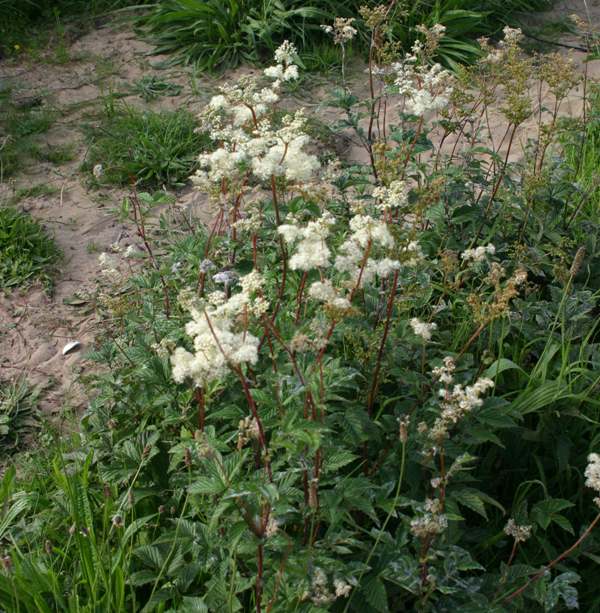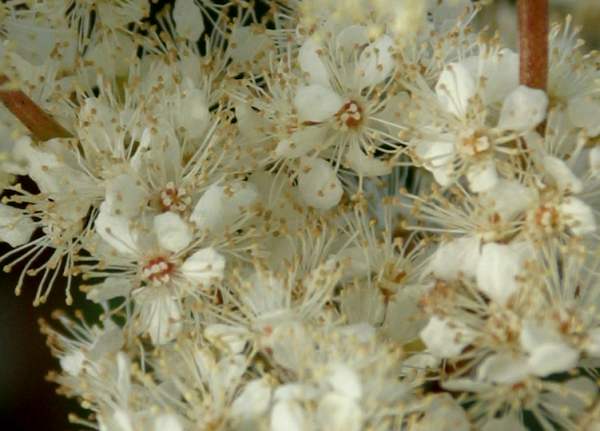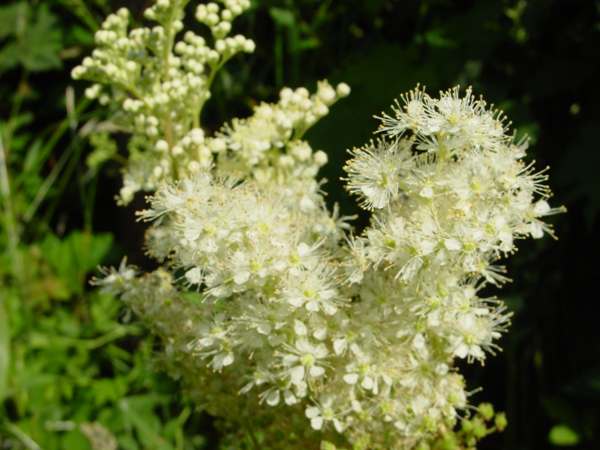Filipendula ulmaria - Meadowsweet
Phylum: Magnoliophyta - Class: Equisetopsida - Order: Rosales - Family: Rosaceae

Description
Meadowsweet is often mistakenly assumed to be an umbellifer.
Typically growing to about a metre tall but occasionally attaining twice that height, Meadowsweet is a perennial herb that propagates both by means of seeds and via creeping underground rhizomes. The leaves of Meadowsweet are dark green and made up of three to five pairs of toothed leaflets with smaller leaves in between. The upper surfaces are smooth (glabrous); the undersides finely hairy.
This wildflower has a sweet and pleasant scent when the flowers first open, but it becomes stronger and almost obnoxious as the flowers fade. The stems and leaves are also fragrant but their smell is subtly different from that of the flowers.
Distribution
Common and widespread in Britain and Ireland, Meadowsweet is native to Europe and western Asia and has been introduced to other parts of the world including North America, where it has become naturalised.

Habitat
At its best in sunlit places beside ditches, pondsand streams, Meadowsweet is also commonly seen on roadside verges and woodland edges as well as in damp meadows.
Blooming Times
In Britain and Ireland Meadowsweet has an long flowering season, beginning in late May or early June and often continuing well in to October.
Uses
The flowers of Meadowsweet contain a high concentration of salicylic acid. This is the compound from which the pain-relieving (analgesic) drug Aspirin (active ingredient acetylsalicylic acid) was initially derived, and it was given that name because at the time the generally-accepted scientific name for Meadowsweet was Spiraea ulmaria - hence aSPIRin.

The purified form of Aspirin was first produced in 1897, but salicylic acid from plants has a much longer herbal history. Not surprisingly, Meadowsweet has long been used in herbal medicines to treat headaches and gastric upsets.
Etymology
Filipendula comes from the Latin noun filum, a thread, and the Latin adjective pendulus which means hanging - a reference to the way that the underground tubers hang upon fibrous thread-like roots. The specific epithet ulmaria is a reference to elm trees (Ulmus species), whose wrinkled leaves are similar to the leaflets of Meadowsweet.
The common name Meadowsweet suggests that this is a sweet-smelling wildflower that grows in meadows, and so it is; however, another of its common mead is Meadsweet, reflecting the fact that the flowers are used, notably in Scandinavia, in the brewing of mead.
Similar Species
Dropwort Filipendula vulgaris is a smaller, less common plant and tolerates drier habitats than Meadowsweet.
The Meadowsweet plants shown on this page were photographed in West Wales in June.
Sue Parker's latest ebook is a revised and enlarged second edition of the acclaimed Wildflowers in the Algarve - an introductory guide. Full details here...
Buy it for just £3.95 on Amazon...
Please Help Us: If you have found this information interesting and useful, please consider helping to keep First Nature online by making a small donation towards the web hosting and internet costs.
Any donations over and above the essential running costs will help support the conservation work of Plantlife, the Rivers Trust and charitable botanic gardens - as do author royalties and publisher proceeds from books by Pat and Sue.



